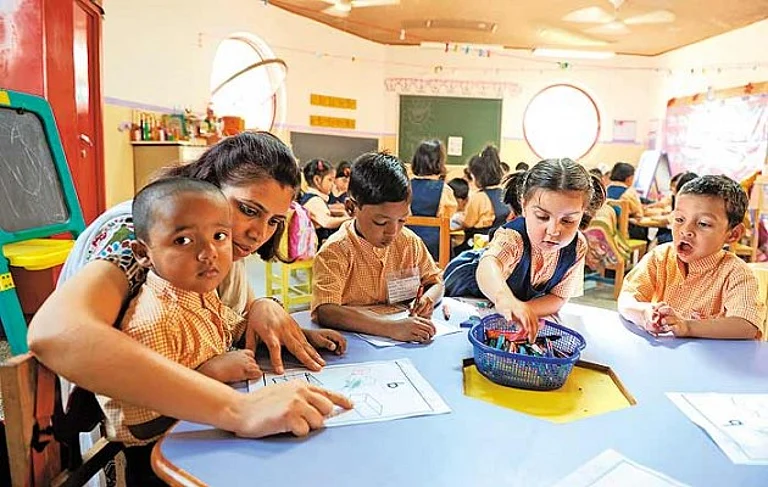From Takeoff To Path Circular
The Launch
- Scheduled for October 22 from Sriharikota in Andhra Pradesh between 6:20 am and 6:35 am. The lift-off time is based on the moon's inclination to the earth.
The Vehicle
- The launch vehicle PSLV-C11 is the upgraded version of PSLV.
- It is 44 metres high and weighs 316 tonnes.
- PSLV has been used 12 times to launch 29 satellites between 1993 and 2008.
The Objective
- To know the moon’s origin and evolution, which may throw light on earth’s evolution.
- To check what minerals are present on the moon.
- To know more about the polar water-ice of the moon.
The Plan
- High-resolution remote sensing of the moon.
- To prepare a 3-D atlas of the lunar surface.
- Chemical and minerological mapping of the entire lunar surface.
The Conception
- 1999-2000: The lunar mission idea germinated.
- June 6, 2003: The Indian Space Commission approved the moon mission.
- Aug 15, 2003: Then PM Vajpayee announced India's plan to the moon.
Future Plans
- 2008: An orbiter around the moon.
- 2012: Soft lander and rover on the moon.
- 2015: A manned mission in space.
- 2025: A manned landing on the moon.
Monitor And Control
- IDSN: Indian Deep Space Network at Byalalu, 35 km from Bangalore, will receive the radio signals from and send commands to the spacecraft.
- SSC: The Spacecraft Control Centre in Peenya, Bangalore, is focal point of all operational activities of Chandrayaan-1.
- ISDC: The Indian Space Data Centre, also at Byalalu, receives, stores, processes, archives, retrieves and distributes scientific information sent by the spacecraft.
How Far Is Moon?
- The moon is the nearest celestial body to earth and is about 3,84,000 km away. It will take Chandrayaan-1 two weeks to reach the moon.
Countries that have sent missions to the moon:
- The then USSR, US, Japan, European Space Agency, China and India.
First mission to the moon:
- Luna 1, by USSR, launched on Jan 2, 1959. A fly-by mission.
First craft to orbit the moon & return:
- Zond 5, USSR, launched on Sept 14, 1968.
First humans to orbit the moon:
- Frank Borman, James Lowell & William Anders, on Apollo 8, launched by US on Dec 21, 1968.
First human to land on the moon:
- Neil Armstrong, Apollo 11, USA, stepped on the moon on July 21, 1969.
Rs 386 crore is the cost of the mission. This includes the Rs 100 crore spent to establish the Indian Deep Space Network.
2 years is the operational duration of the moon mission.
1,380 kg is the weight of the spacecraft at launch.
11 is the number of payloads or scientific instruments. Out of this five are Indian, six are foreign hitch-hikers.
***
On October 3, Mylswamy Annadurai, the mission director, Chandrayaan-1, is visibly tense. The spacecraft, moved out the previous day from the laboratories of the ISRO Satellite Centre in Bangalore, is being transported at 20 kmph by road to the spaceport in Sriharikota, some 300 km away. Annadurai is tense because a local newspaper has gone and splashed the picture of the convoy on its front page. He now fears for its safety: "We did not want this sort of publicity. If something happens to the spacecraft, it will be very painful. Given the times we live in, anything can happen. All the hard work that we have put in will go down the drain. And our image will go for a toss internationally."
Even as he is expressing anxiety, Annadurai is planning his trip to Sriharikota that evening. Like an anxious parent, he can’t wait to be reunited with the satellite, with which he has spent an average of 16 hours every day over the last four years, during which it was put together. In the last three months, the pace of work has become frenetic, with his team of around 400 working round the clock, in three shifts.
The moon mission is a first-of-its-kind project for ISRO, involving people across different space agencies, continents and time zones. Big players like NASA, the European Space Agency (ESA) and the Bulgarian Academy of Sciences are hitching a ride on our vehicle (PSLV-C11) to the moon, and of the 11 scientific instruments on the satellite, six belong to foreign space agencies and five to India.
"The expectations have gone up because of foreign participation," says Annadurai, who recalls how the decision was taken. When the moon mission was being planned four-and-a-half years ago, the big question was whether or not it should take on board US and European instruments. Some thought this might end up hijacking the mission out of India’s control. But Annadurai successfully argued for their inclusion: "I said please give me an opportunity to lead the teams from US and Europe. This will enhance the prestige of ISRO. They agreed. Today, as the satellite is on the way to the port, I feel the nervousness of an opening batsman."
A multitude of ancillary tasks occupy Annadurai before he leaves for Sriharikota—revising a publicity brochure on the mission, fielding a flurry of phone calls, giving instructions to his staff, as scientists walk in and out of his office. In between, he pauses for a few seconds to sign the approval for a junior scientist (who would not otherwise be entitled to travel by air) to fly with him that evening. It’s a part of his job, he says, making even the youngest team member feel indispensable. "Each one knows his task here and takes full responsibility for it. It may sound like a cliche but this indeed is a family—the Chandrayaan family." The average age of this family is about 45 years, and a good number of its members are in their mid-30s. The young scientist who is flying with his boss is just 28.

| All set: The lauchpad from which the satellite will be carried to the moon |
The spirit that guides the spacecraft on its journey of nearly 4,00,000 km has to be young, says ISRO’s chairman, Madhavan Nair. "Young, bright scientists can be attracted only by technology challenges, not by money alone," he says. Annadurai recounts one such challenge his team faced and describes the ingenuity with which it was handled. It had to do with the stringent requirements of the foreign agencies to keep their instruments in an absolutely clean environment, uncontaminated by even a cough or sneeze in the laboratory, as this would affect their ability to send back accurate data. "We thought we’ll show the world that we can also match their stringent standards. If they brought their own systems to keep their instruments clean, that wouldn’t reflect well on us. It would be like guests bringing their own food to your house, because the food you served was stale. We managed to create an indigenous system to keep the instruments clean with a continuous flow of liquid nitrogen. This is a portable system that can be moved across the laboratories when the satellite moves for different tests. Meeting this challenge gave us a lot of satisfaction and confidence." The deep space network in Byalalu, outside Bangalore, was similarly built indigenously, to receive radio signals from the spacecraft orbiting the moon and also to send commands to it. As K.B. Anantha Rama Sarma, the associate project director of Chandrayaan-1, puts it: "What is the driving force behind us? Money? No. Power? No. Fame? No. It is pure self-motivation and dedication."
As much as the moon mission is thriving on challenges, it is also about securing the future. It may be purely coincidental that the nuclear deal has happened around the same time as the moon mission, but there are linkages between the two. As Madhavan Nair points out, "Suppose we are able to find Helium-3 on the moon, we can commercially exploit it for our atomic programme." In fact, one of the main objectives of Chandrayaan is to map minerals on the moon. The spacecraft will carry a scientific instrument called the hyperspectral imager. This will collect data for mapping the minerals on the lunar surface as well as for understanding the minerological composition of the moon’s interior. Another instrument called the high-energy X-ray spectrometer is designed to identify regions with high concentration of uranium and thorium. When the lunar impactor is ejected from the Chandrayaan spacecraft and when it pitches the tricolour on the lunar surface, that would also be about staking claim to a share in "the spoils of the moon" when the time comes, says Pallava Bagla, the author of Destination Moon, a book on India’s space quest and moon mission.

An artist's impression of Chandrayaan 1
As we trail Annadurai and his team to Sriharikota, we notice the launch pad standing patiently like a meditative pelican in Pulikat lake, just outside the spaceport. To the core team of 400 are added a few hundred more scientists, and around 1,700 technicians. The scientists have already begun speaking the language of midwifery. The satellite will "mate" with the launch vehicle around October 17 after several rounds of tests, and then move slowly from the integration area to the launch pad. As the vehicle readies for the October 22 launch, "umbilical lines" will nourish the launch vehicle with propellants, coolants and gases. It will finally be "delivered" into the moon’s orbit at an optimal lift-off time of 6:21 am.
The launch time is not determined by astrology, but is based on the moon’s inclination to the earth. ISRO does not want to miss the October 22 launch date because "historically, after October 22 the heavy Northeast monsoon sets in and the weather may not be good. Cyclones and depression are possible," says M.Y.S. Prasad, associate director of the Sriharikota spaceport. Meanwhile, quietly, the countdown to Chandrayaan-1’s rendezvous with the moon has begun.

























